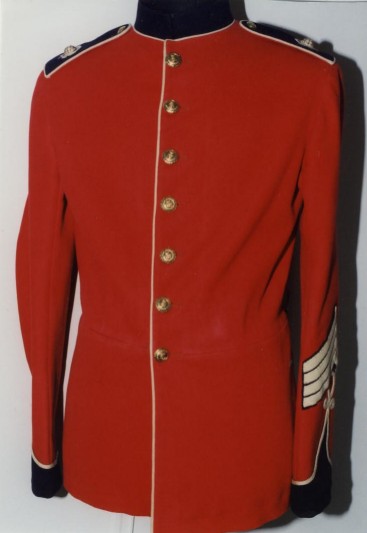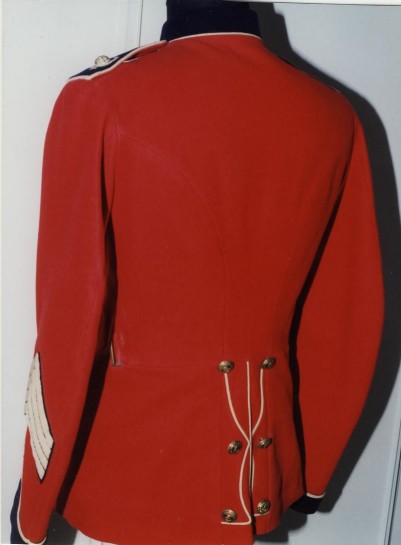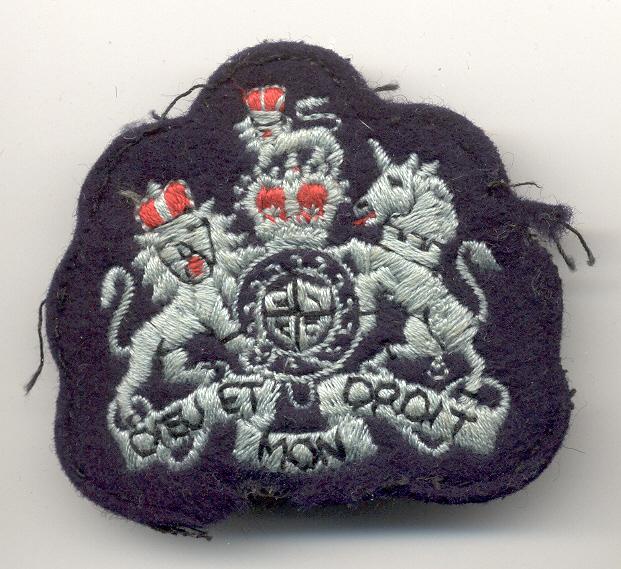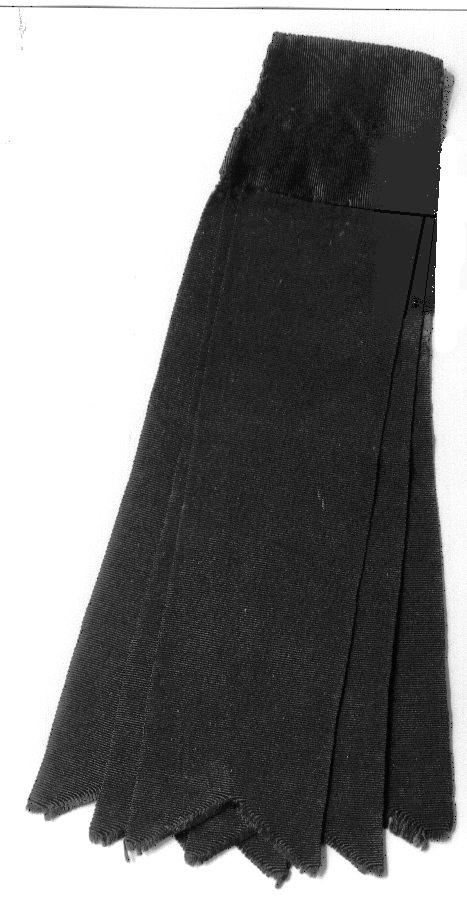
david grumpy
-
Posts
46 -
Joined
-
Last visited
Content Type
Profiles
Forums
Blogs
Gallery
Events
Store
Posts posted by david grumpy
-
-
-
unfortunately, the fag card illustration is pure rubbish!
0 -
No. It was however Indian issue, although the example shown is a variant I have not seen before, with the little spiky bits indicating compass points. The Indian government were responsible for clothing ALL british soldiers in India, and erred on the economical side, shall we say. Cavalry scouts in India wore the regulation British fleur de lys.
I have a few ills. of the S wreath badge worn on the Western Front by units fresh from India.
The 'jacket' is the standard Indian Pattern dress frock, unlined but tailored and fitted. It has the same cuff, facings, collar etc as worn in the period of the Zulu war, long since replaced at Home. SNCOs had piping to the frock front and bottom.
0 -
Thanks for the tip Graham, will certainly try and track a copy down!!!
You only have to PM me!
0 -
first regimental numbers officially 1829 BUT several 'with it' regiments had introduced them long before that!
0 -
Hi Guys,
Many thanks for all your replies. It appears that yes the Flash was worn by all ranks, when on ceremonial duties, guard & when walking out, however, only the Officers appear to have worn it whilst in the field. I have found some pictures of Officers in France (1944/45) giving an O group, were the Flash can clearly be seen, I`ve also found pictures of O/R`s were they do not have the Flash on, again in France 1944/45. Interestingly it was the TA Battalions that served in France during this period, the Regular battalions where both in Burma.
Finally, yes the new `super` Regiment does still wear the Flash & the Hackle, but they have a new cap badge.
Senior NCOs and WOs of 2nd RWF wore the flash on SD in the Great War as I understand it. A sergeant when offered the [staff] appointment of Sgt Cook asked "and shall I wear the flash?"
0 -
Surprised and disappointed that no badge of RM CSgt has been shown .... very colourful, lots of changes, and every bit as collectable as Guards Division.
0 -
Hello David,
Actually I have obtained the original owner's records from the NA (I almost wrote PRO
 ). The name, Division & number all figure in the tunic.
). The name, Division & number all figure in the tunic.So please can you say when the 4th chevron was awarded ...... after how many years? I ask because I wrote [i believed] the definitive account of these badges for MHS Bulletin and, if RM rules were different, MHS will publish an update from me.
0 -
There is some dispute as to when this was 'introduced'. Army Order 10 of January 1902 described it and used the future tense:
"during the transition period and for some time after the introduction ....."
"will first be supplied ....."
etc
Perhaps those with regimental histories covering the period could have a look?
0 -
Any one who seeks true understanding of the subject needs a copy of the JSAHR Special by Major Nicholas Dawnay "Badges of Rank of WO and NCO in the British Army". Scarce as rocking horse by-product but there is, as far as I can tell, only one error in it.
Re. the CSgt wearing of the Colour badge ...... it was only EVER authorised and provided for the scarlet dress tunic .... all scarlet frocks, all SD, only ever had the crown and three chevrons alone. Some garments had NO badge authorised.
The only exception to this is the 5 button Indian Pattern Scarlet Frock, provided by the Government of India as the 'best' winter uniform. This bore the colour badge. The only tunics provided in India were for the ViceRoys household troops.
0 -
RMLI OR Full-Dress tunic, dated 1895. The GC&LS 'undetected crime' stripes are original to the tunic (21 years as a private !).
Why 21 years? According to my research the RM [both branches] followed army rules for GC badges, which would mean at that period max. 18 years, min. 16 years [for continuous good behaviour] ..... ? At that time, 4 chevrons were commonplace, for example many bandsment all services were long serving and promotion was very slow.

 0
0 -
Yes, I have absolutely no doubt that regimental practice varied. Even today, the Household Cavalry use a worsted crown versus a metal crown to distinguish [this from memory] LCpl of Horse from Cpl of Horse in SD
0 -
The rank RSM for the regular infantry actually only appeared on the advent of the Great War, which is when the 'Royal Arms' badge was adopted prior to that the rank was simply 'Sergeant Major', the badge of rank being a large crown worn on the lower right cuff in both bullion with full dress or khaki worsted with SD. On the introduction of the rank 'RSM', in compliance with the introduction of the four company system, the eight Colour Sergeants within the infantry were also re-ranked - the four senior 'Colours' then became 'Company Sgt Majors', they adopted the crown of the former Sgt Major, but slightly smaller as their badge of rank. The four junior 'Colours' then became 'Company Quartermaster Sgt's'. Their badge of rank was the crown worn above the three sgt's stripes.
The Colour Sgt's had their own bullion badge of rank for full dress, which was the crossed union flags above which was a crown above three chevrons, but there was no equivalent for SD and a compromise was adopted where a large crown was worn above the three chevrons. As stated above this was to become the badge of the CQMS the restructuring of the infantry ranks.
The RQMS retained his rank and badge which was four inverted chevrons on the lower cuff above which was a small star.
The system gets even more complicated when looking at the rank and badges of those serving with the Volunteers/Territorials
Graham, a few points of detail:
RSM, as you will recall, was not a rank, but an appointment. It became necessary to change the title of the appointment of the senior soldier in the battalion from 'Sergeant Major' as soon as Company Sergeant Majors were appointed. This was first described in AO323/1913 October ...... "these duties [CSM and CQMS] will be carried out by the existing Colour Sergeants".
No longer could the senior soldier be the SM, with four other SMs about [who were at that time two ranks junior to him, with all [R]QMSs in between].
The new CSMs retained their SD rank badge of three chevrons and crown [see CSM Barter VC, always badged thus] [i have no evidence that Colour Sergeants changed the size of the crown when appointed CSM, and can see no good reason for it in time of war] until order was restored and a second grade of Warrant Officer was created [AOs 70, 168 and 174 of 1915]. Until then, a RSM wore the crown, a RQMS continued with four chevrons and star, a QMS not appointed as RQMS just the chevrons, and a CQMS as CSgt badges.
With the creation of WO II, CSgts appointed CSM took the crown, and WO I appointed RSM took the Royal Arms. The poor old QMSs were lumped in with the CSMs [they had hitherto been their seniors] and were to wear the crown also.
Finally, AO 309 of 1918 gave the RQMS WO II back his dignity of a new usage of the crown within a wreath, thus showing the senior appointment.
0 -
A couple more, next is the Royal Air Force WO1 badge in pale blue on a navy background.

Following that we have the Royal Engineer, Royal Signals and REME version of the RSM badge with a navy border.

Please note Royal Air Force does not, and never did, need two grades of Warrant Officer. All RAF WO are equivalent rank WO I only cleverer.
0 -
other than that he went to F&F on 11 Aug 1914 as CQMS [rank CSgt] of A or B Coy, and that he was never RSM of the battalion? He served in India with the battalion pre-war. Will dig around.
0 -
The reprint is fine if you want to be up-to-date, but suffers fate of many a reprint : degradation of picture quality. Churchill's collar dogs is a prime example of this problem.
0 -
I assume you have the 2005 reprint with added info? Denis did it on his own, he 'thought Langley was dead!'
0 -
The only reference to its being early I can think of offhand is "British Army Proficency Badges".
Thank you: I don't disown the book, which I co-authored, but if I were to start again today, there would be a lot of changes!
0 -
The early enamelled brass, the plain brass - same sized badges, just I've messed up the res:
any evidence please to support the contention that the enamelled flags badge was 'early', earlier than the plain gilding metal ['brass']?
I ask because neither the Royal Army Clothing Department ledgers, nor Clothing Regs, nor Priced Vocabs [i have complete copies of all this info from c. 1850 to 1950] give any hint of an [expensive to produce] enamel version.
My belief, which is up for challenge, is that the enamelled version is a vanity individual item, or a collective regimental vanity, and that it was never an Ordnance item. India, with its skilled native craftsmen, might be the source of the enamel badges.I think the only proof needed to knock my theory is a Sealed Pattern.
0



The Flash
in Great Britain: Militaria: Badges, Uniforms & Equipment
Posted
Worn in France by Captain 'Tiger' RN Philips, KiA October 1914